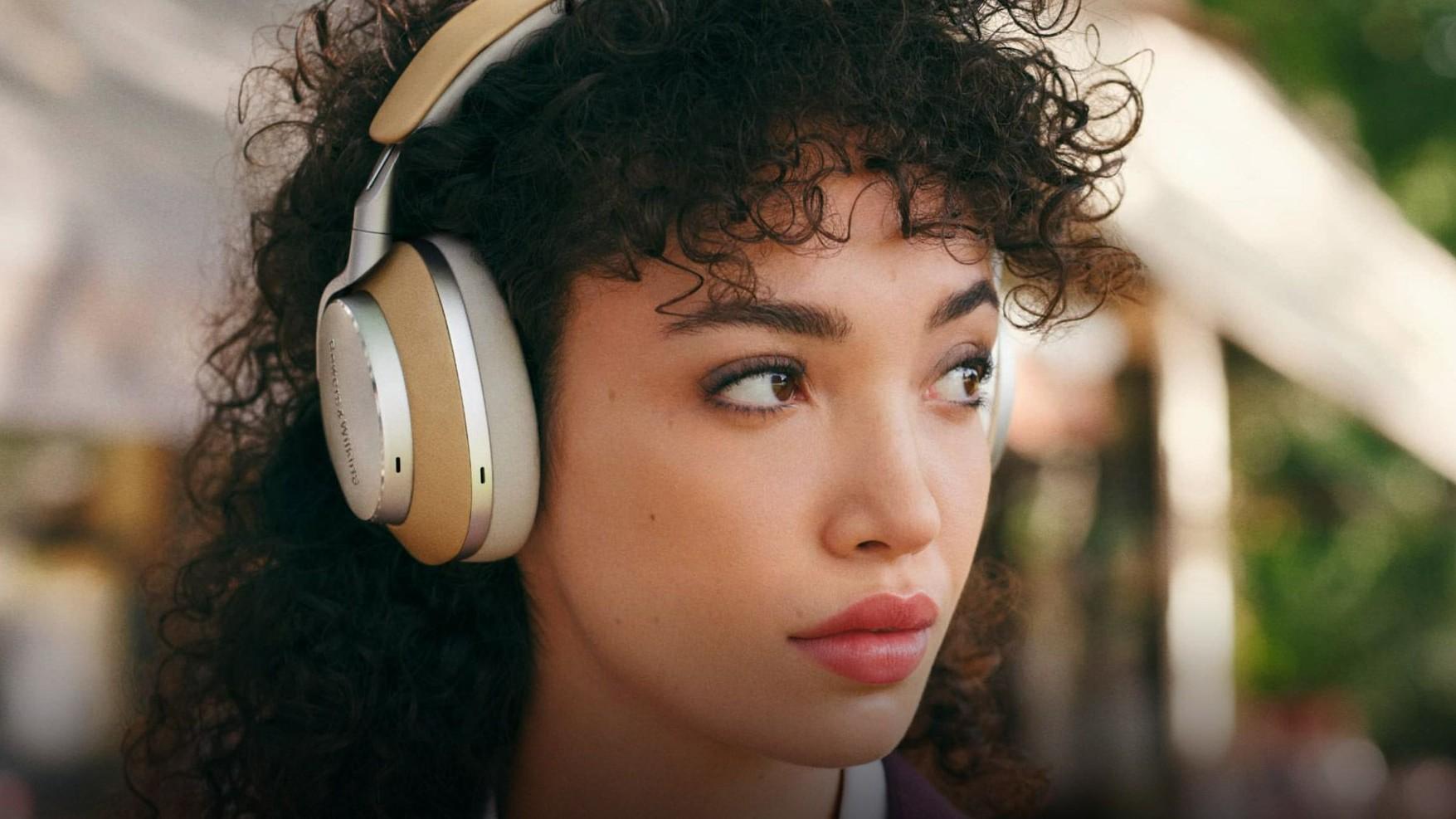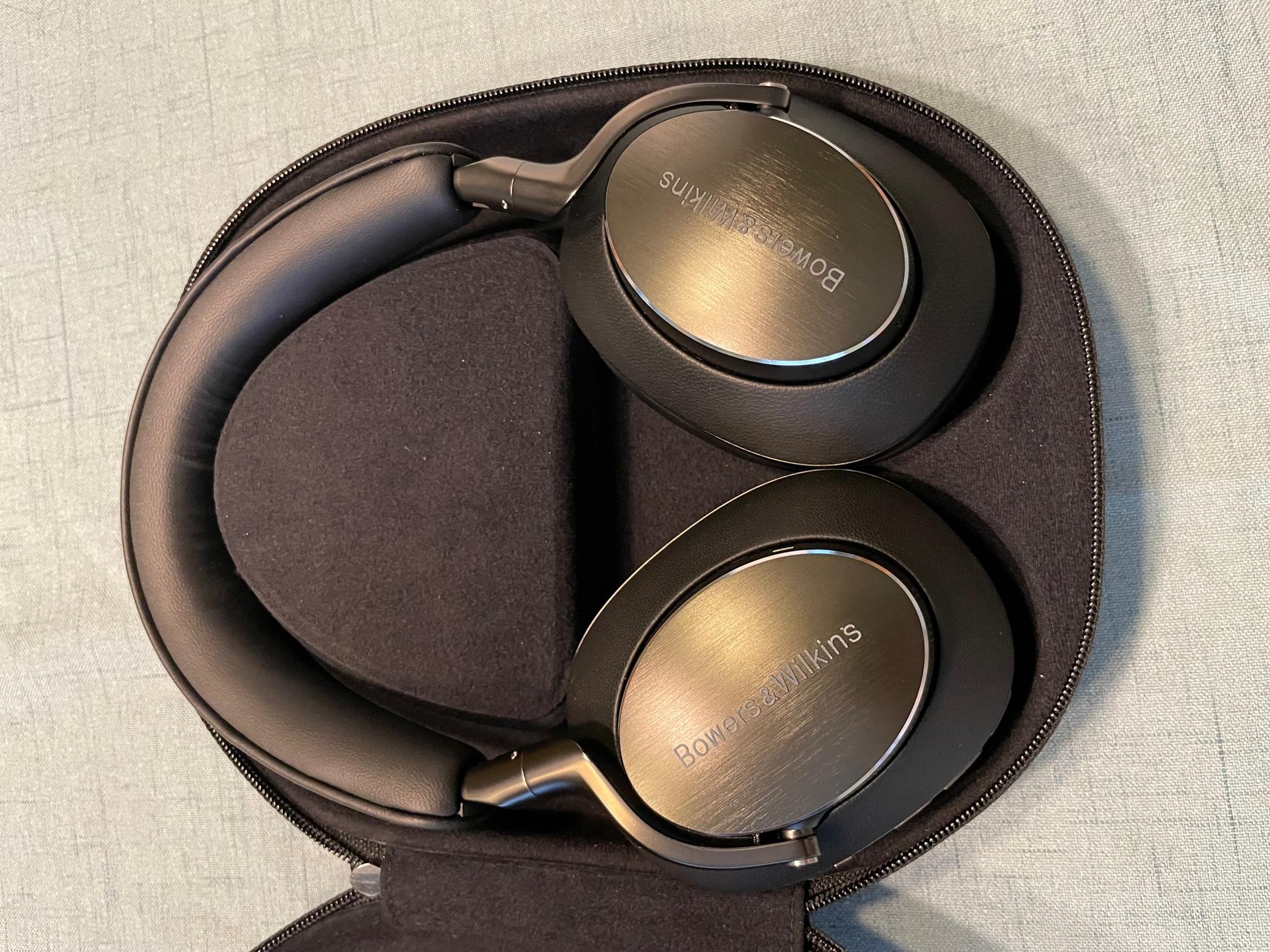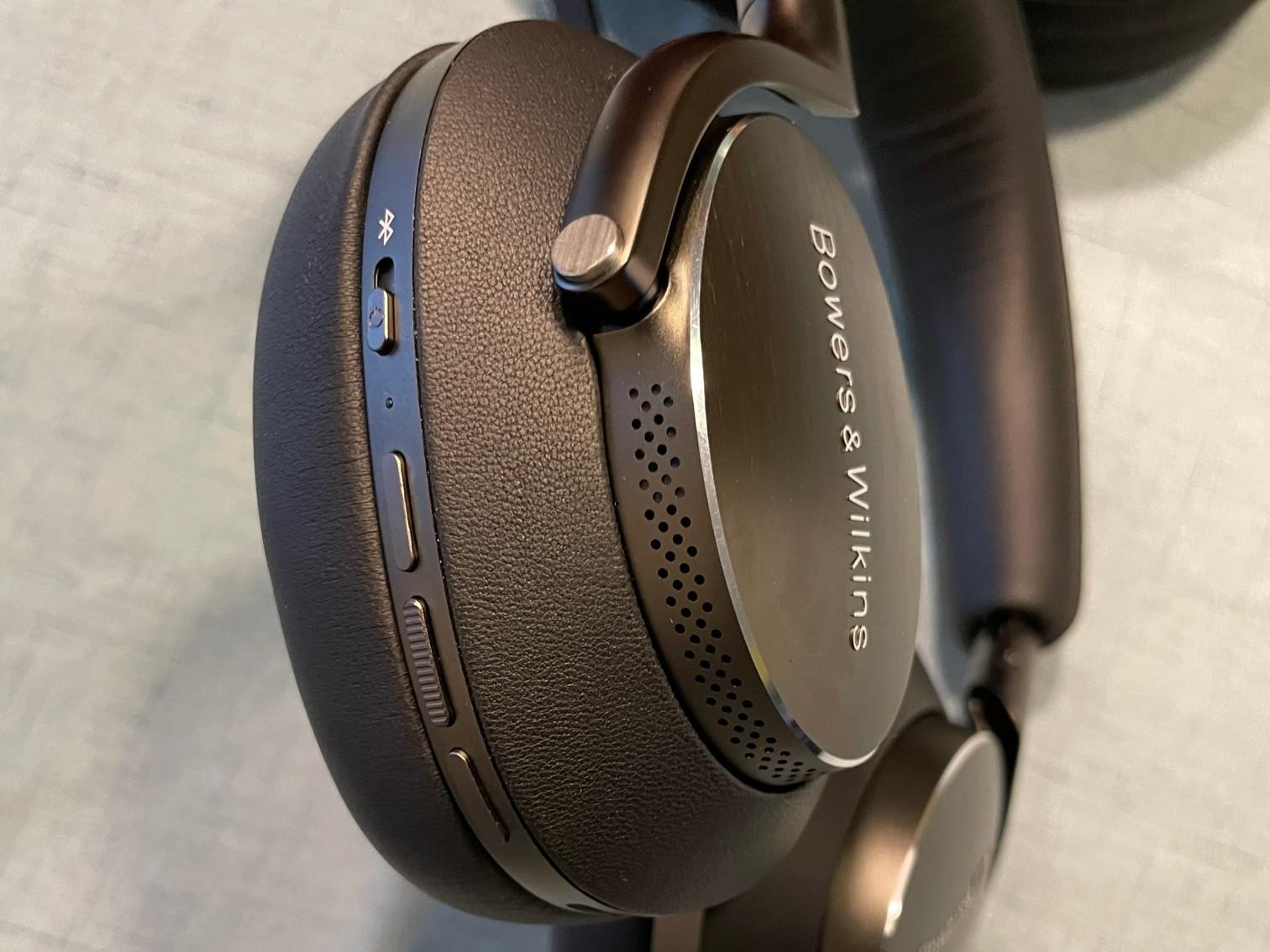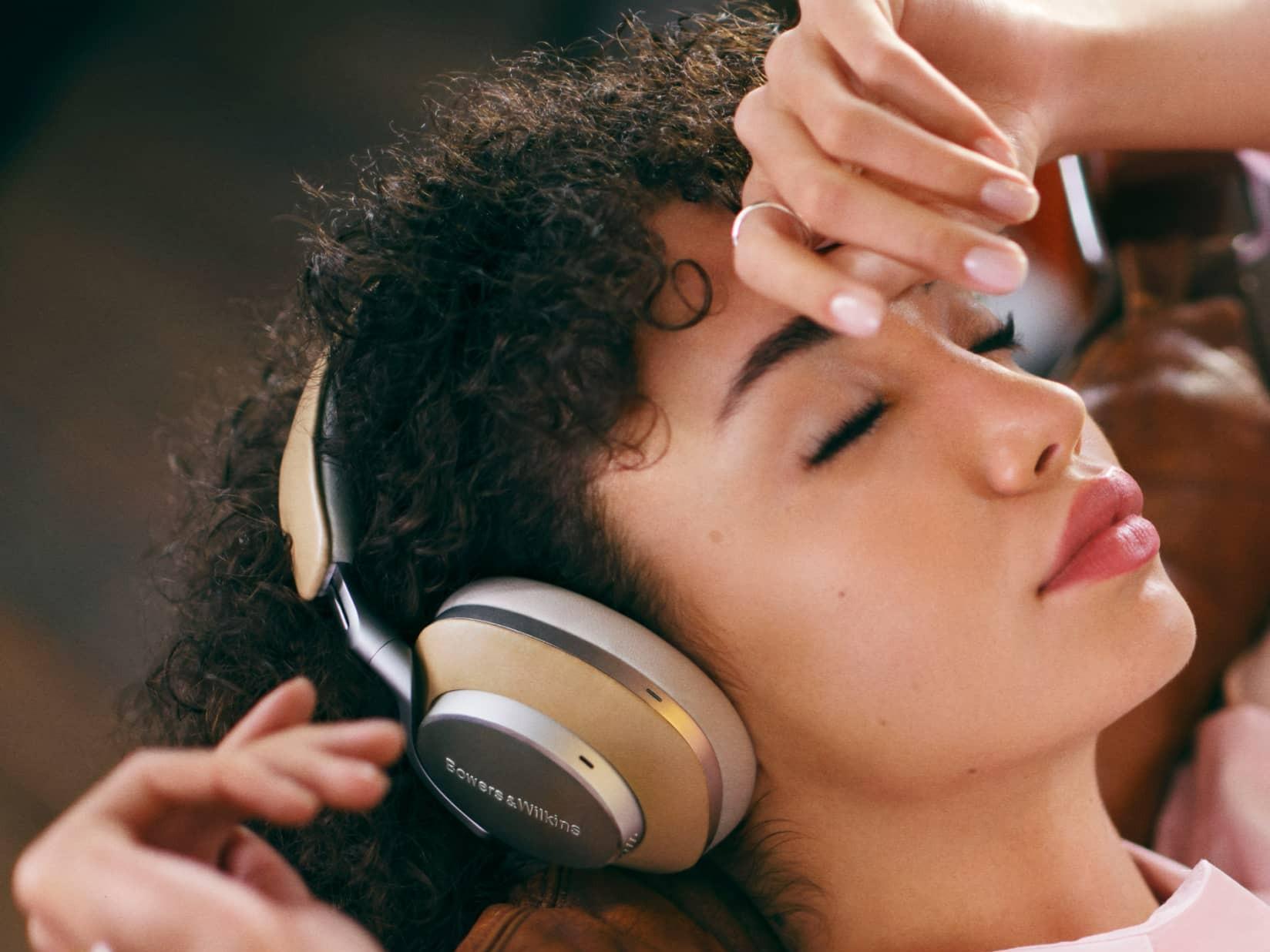

My colleague Mark Henninger really enjoyed the Bowers & Wilkins Px7 S2 wireless headphones, so I was interested in reviewing the company’s newest flagship model, the Px8. I was a bit skeptical that this pair of headphones with relatively similar looks and specs would justify a $699 price tag, $300 more than their siblings. But those looking for top-notch audio performance will find a lot to like in B&W's step-up wireless headphones.

Starting with the hard carrying case, the two latest pairs of headphones from B&W appear very similar, but the Px8 has a leather zipper pull tab in comparison to the fabric tab on the Px7 S2 case. The interiors are different colors, but both safely protect the headphones and provide a compartment for cables. The Px8 appear to replace some of the plastic parts with aluminum. The Px7 S2's vegan leather is also replaced with Nappa leather here.
The outer faces of the Px8’s earcups have brushed aluminum plates with a bright, beveled edge. The Px8 come in tan or black rather than the Px7 S2’s grey, black, and blue color options.
It's inside the Px8 where the most important changes are found. While both headphones feature angled, 40-millimeter drivers, the Px8's upgraded drivers are a new Carbon Cone material coupled to an updated drive system and surround. Bowers & Wilkins claims this new driver system is key to the Px8's improved detail.
While many manufacturers claim that each new generation provides improvements, here we see specific changes to back it up. The new cone material should be stiffer than the prior iteration and the larger drive structure should provide better control.
The Px8’s Active Noise Cancelling (ANC) system offers the usual three settings: noise canceling, ambient noise pass-through, and off. The Bowers & Wilkins App which works with both the Px7 and Px8 was updated to include integration with Tidal, Deezer, Qobuz, TuneIn, NTS music services. Within the settings, you can adjust the ANC mode, the Quick Action button, the sensitivity of the wear sensor, and more.

Getting going with the Px8 is as easy as you’d expect from a pair of flagship headphones. I charged up the batteries with the supplied USB-C cable and soon had 30 hours of battery life at my disposal.
Pairing the Px8 with my iPhone was simple enough, and Android devices can take advantage of Google Fast Pair for even easier connection. The headphones support multipoint pairing, meaning a second device can be connected simultaneously if you wish. You'll also find a 3.5mm cable if you prefer to plug in.
The Px8 are slightly heavier than the Px7 S2 at 320 grams / 11.3 ounces, but the padding and fit were comfortable on my larger-than-average head, as well as on my teenage son’s much smaller noggin. The left earcup has the Quick Action button which can be configured to activate your voice assistant or toggle ANC modes. The right earcup has power, volume, and multifunction controls as well as a USB-C port on the bottom. There are no touch or swipe controls.
Listening to “bury a friend” from Billie Eilish’s album When We All Fall Asleep Where Do We Go (Tidal, Interscope) I found that Eilish’s vocals were solidly placed in the center of my head, apart from the hard pan effects. This track is filled with deep, synthesized bass notes which were powerful and articulate.
Switching back and forth between the Px8 and the Px7 S2 with this track and others, the difference in the lower frequency reproduction was noticeable and repeatable. The Px8 extended lower but with more detail and control which seems to change the tonal balance to lower the bass presence as compared to the Px7 S2. The Px8 still offer strong bass but are tuned to a more neutral presentation.

Lori Liberman’s version of “Killing Me Softly” from her newest album, Truly (Qobuz, Drive on Records) is about as different from Billie Eilish as I could get while staying with female vocals. This well-recorded album was well portrayed on the Px8 with Liberman’s voice, guitar and piano all delicately but firmly placed.
I noticed almost all the same nuanced details in the Px8 as I found when I listened to this piece on my reference stereo system, which currently consists of a PS Audio DirectStream DAC feeding a McIntosh C-500 preamplifier and the amplifier section of a Krell FBI which drives Revel F328Be speakers.
I mixed it up a bit when traveling on a recent trip to Chicago, making use of all six of the Px8’s microphones for both noise canceling and telephone calls. The Px8’s noise canceling was extremely good at suppressing the usual flight noise, but I think it was just a notch behind the Bose QC45 and Sony WH-1000XM5. The wear sensor worked reliably, pausing the music when I pulled the earcup away to speak with my family.
I found the passive isolation to be slightly better with the Px8’s Nappa leather ensconced earpads as well, making the pass-through mode even more helpful when I needed to hear the world around me.
In looking through current offerings, there were a couple of options that were competitive. (See our Headphone page for all the options we have reviewed.)
The Bose Noise Cancelling Headphones 700 ($379) are Bose’s answer for a high-end, luxury product. They have a modern aesthetic and solid build quality, and are obviously a fair bit cheaper, but the Bowers & Wilkins headphones pull ahead with sound quality. I did not get to compare noise canceling on these and the Px8 back-to-back but, based upon memory, they are comparable in effectiveness.
Apple’s Air Pod Max ($549) also feature premium construction and some of the best noise canceling available. The Apple headphones are bigger and heavier but have a rich feature set, especially if you are in the MacOS and/or iOS world.
In comparison to my wired, passive reference headphones from Mr. Speakers Aeon Flor (closed back) or Audeze LCD XC, the Px8 had a narrower soundstage and missed that last bit of detail but those other options are designed to be used in a totally different environment and with quality, outboard amplification.
The other headphones I think will be stiff competition are Bowers & Wilkins’ own Px7 S2 ($399). They offer similar styling and much of the Px8’s performance at a significantly lower price point.
The Bowers & Wilkins Px8 headphones raise the bar on premium, noise-canceling headphones both in build and sound quality. Throughout many listening sessions, they provided a full and warm sound while still clearly reproducing details that were smeared or lost in lesser headphones.
In comparison to my favorite wired headphones, the Px8 impress me by how much performance they provide in a smaller, self-contained package. Adding wireless connectivity and noise-canceling in such a high-performing package allows you to bring a bit of your audio luxury with you on the road.
2023-04-14 00:13:51
Acunetix